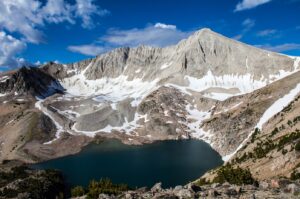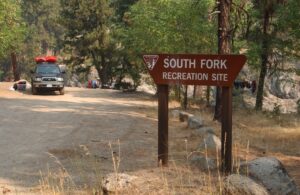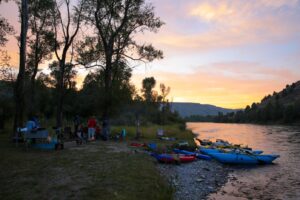Here in Idaho, we’re lucky to have countless places to camp and recreate outdoors. Wherever and however you choose to get outdoors – recreating responsibly is vital to protecting you, other recreationists, and the land, water, and wildlife we all love. In this 5-part blog series, the Idaho Conservation League is helping you recreate responsibly with easy tips and tricks that make a difference – giving back to the lands that give us so much.

Whether you’re on a weeklong trip in Idaho’s backcountry, a day hike in the woods, or on a rafting trip down one of Idaho’s wild rivers – oftentimes, when out in nature, nature calls. And when it does, you need to be ready.
Being prepared and planning ahead is a key aspect of recreating responsibly, and is one of the seven Leave No Trace principles. So is disposing of waste properly, and leaving the ground as clean or cleaner than you found it. That means packing out what you pack in, and cleaning up after yourself – including when you go to the bathroom.
Nobody wants to see loose toilet paper on the shore of a beautiful mountain lake, or in eyeshot of their favorite hiking trail. Proper disposal of human waste is also important to avoiding water pollution, minimizing the possibility of spreading disease, and protecting ecosystems and wildlife. The key to disposing of your waste properly starts with being prepared.

Know before you go
Before you head out on your adventure, find out if there are any regulations on human waste in the area you are headed. Some sensitive or heavily trafficked areas require you to pack it out. If you forget to check those regulations and are unsure when you have to go, you need to pack it out.
After you’ve checked for regulations, make sure you have the necessary supplies and know the proper techniques for going to the bathroom outdoors.
Supplies:
- Hand sanitizer
- Toilet paper
- Sealable plastic bag like a WAG Bag (to pack out your waste AND the toilet paper used). WAG bags are leak proof, double-layered bags that are perfect for day trips and longer excursions where you don’t want to worry about leaks or smells. For more human waste disposal options, click here.
- Trowel (for digging, if you are burying your waste in an area that allows)

Finding the appropriate spot
Now that you have your supplies, it’s time to find the right spot to do your business.
If you are allowed to bury and leave your waste in the area, you need to be at least 200 feet away from any trails, campsites, or water sources when you go to the bathroom. Be sure to stay aware of your surroundings when looking for your spot, so you can easily find your way back. If you are stepping off a hiking trail, leave your pack on the trail so that if you have an emergency while doing your business, people will know where to look for you.
Try to find a spot that has loose soil and is in the sun. These conditions help waste decompose more quickly. Use your trowel (or a stick or rock) to help dig a hole at least 4 inches wide and 6 inches deep to go in. After you go, be sure to pack out your toilet paper. Then, cover up the hole you dug and disguise it by scattering leaves or pine needles over the site so you don’t leave a trace.
If you are in an area that requires you to pack out your waste, or are doing so because it’s the best option, commercial “WAG (Waste Alleviation & Gelling) bags” are great and easy to add to your gear. They’re used to collect and carry human waste in the backcountry or anywhere else you need. Each bag is puncture-resistant and contains hand sanitizing wipes, some toilet paper, and powder that solidifies and neutralizes your waste so you don’t have to worry about any spills or smells. We recommend bringing extra hand sanitizer and toilet paper with your WAG bag to ensure you don’t run out of either. WAG bags are also lightweight – so you won’t notice much difference when putting them in your backpack. While you can pee in a WAG bag, it is better to pee in the river or away from camp as pee takes up space and adds weight.

If you are on a river trip, use the Groover! However, don’t pee in the groover as that will take up valuable space. Instead, pee in the river so you don’t fill up the groover or stink up your camp. Groovers and WAG bags are good ideas even on day trips.
Packing out your waste is the most environmentally friendly method, so we encourage you to do so even if it is not required.
Idaho’s wild spaces are too great for any litter or waste. Recreating responsibly and packing out waste can help keep our public lands and waters clean and healthy. If we all do our part, we can keep Idaho’s wild spaces pristine for generations to come. For more information on recreating responsibly, planning your next Idaho adventure, and ways to stand up for Idaho’s special places – sign up for our public lands campaign emails here.
